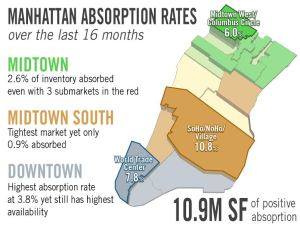 A colleague told me the other day that absorption is boring. But like shark-infested tornados in New York City, absorption cannot be ignored! For the past five quarters, Manhattan absorption has been positive, and with another 1.6 million square feet of positive absorption posted in July, the market is well on its way to another quarter with a decrease in available supply. In the past 16 months, 10,912,692 square feet of positive absorption was recorded. In order to make the statistics an even playing field for all the markets, let’s take a look at the absorption numbers as a percentage of the overall size of the market and see which area’s demand is outpacing space returns.
A colleague told me the other day that absorption is boring. But like shark-infested tornados in New York City, absorption cannot be ignored! For the past five quarters, Manhattan absorption has been positive, and with another 1.6 million square feet of positive absorption posted in July, the market is well on its way to another quarter with a decrease in available supply. In the past 16 months, 10,912,692 square feet of positive absorption was recorded. In order to make the statistics an even playing field for all the markets, let’s take a look at the absorption numbers as a percentage of the overall size of the market and see which area’s demand is outpacing space returns.
Lower Manhattan has the highest percentage of positive absorption and is the only market to record positive absorption in all of its submarkets over the last 16 months, as 3.8 percent of its total supply was absorbed. The World Trade Center submarket accounts for two-thirds of the positive absorption for all of the downtown market, with 7.8 percent of its inventory absorbed since April 2013.
Despite three Midtown submarkets posting negative absorption, Midtown’s demand still outpaced supply, with 2.6 percent of its inventory absorbed since the second quarter of 2013. Midtown West/Columbus Circle had the highest percent of inventory outpace space returns. That combined with the Sixth Avenue/Rock Center and Fashion District submarkets accounted for 72 percent of Midtown’s positive absorption over the past 16 months.
Although Midtown South is the tightest market of the three, when considering only absorption it is the weakest. Demand outpaced space returns by less than 1 percent of its overall inventory due to the Chelsea/Meatpacking and Flatiron/Union Square submarkets recording negative absorption. The Soho/Noho/Village submarket had the highest rate of absorption out of all 17 submarkets, at 10.8 percent.
After writing this, I now realize my colleague was correct—absorption isn’t the most interesting statistic to analyze, is it? I promise a shark-filled-tornado of statistics next week!


